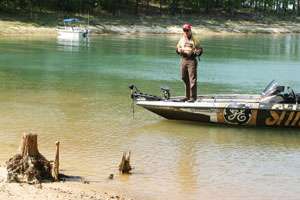
It was February 2008, and common sense told Brent Chapman that if he was going to have a chance to win the Bassmaster Classic on Lake Hartwell, he had to fish deep.
But he couldn't resist the temptation.
"I knew the deep patterns were going to be key that time of year, but I'm more comfortable in shallow water and had to see if there were fish up there," he recalls.
He idled into the back of a shallow creek so far the motor kicked up mud.
"I dropped the trolling motor and began casting at a dock that was half out of the water and instantly caught a fish," Chapman says. "That bass was holding in less than a foot of water, several hundred yards from deep water."
Using his keen eyesight and a stealthy approach, Chapman finished 23rd by fishing his strengths, catching bass in knee-deep water on a lake best known for producing deep water bass.
He says most anglers know that largemouth bass love shallow water but they overlook areas lacking abundant cover, don't fish shallow enough or avoid shallows when local experts say you have to fish deep. There are more bass shallow throughout the fishing season than most anglers realize, he adds.
"Everyone fishes shallow in the spring, but they often don't go shallow enough or they abandon shallow water the rest of the season," he says. "Many who do fish shallow don't fish it properly."
Fishing ultrashallow water requires some forethought and skills, he notes. Bass don't need a lot of cover to hold them and some of the best spots are subtle, therefore they are difficult to detect.
For example, seemingly barren, shallow banks that don't hold a lot of visible cover can be great places to find a quality bass or two.
"Especially at a place like Hartwell, where most of the banks are so clean out to about 30 feet, which is one reason the deep water fishes so well," he explains. "So, in a place like that, one shallow stump, rock or log is a fish magnet."
Cover isn't the only clue to good shallows, especially on lakes with limited shore cover. Chapman says he looks for transition areas, such as where the bottom composition changes from clay to gravel.
Bass will use those transitions. The change also may indicate a difference in bottom depth or the presence of a silted channel swing near the bank, both of which will attract bass.
"A subtle depth change, especially in the far backs of creeks, can be huge," he says. "A lot of those areas are silted in, but if you see the depth change from 1 or 2 feet to 3 or 4 feet, those are places to key on. Any nearby cover could hold a fish."
Chapman prefers creeks because the water tends to be more stained and the fish are less likely to be spooked. The stained water makes it a little more difficult to see, but it helps him sneak up on the fish better.
"You've got to be conscientious and not let the fish know of your presence," he advises. "I keep my shadow behind me and operate the electric as low as possible."
He also turns off his rear graph to eliminate pulsing sounds from his transducer and raises his outboard so that the lower unit isn't scraping the bottom or bumping objects that could spook the fish.
"I use a Power-Pole (shallow water anchoring system) and keep a remote button fastened to my belt for easy access," he describes. "If I unexpectedly see a log or rock that I want to fish, I can stop the boat without reversing the trolling motor."
Chapman also opts for lighter weighted jigs and sinkers on soft plastics that will create less noise when they hit the water.
"Make casts behind the object and work it into the cover," he explains. "That's more natural and less likely to spook fish."
SEEING IS BELIEVING
Not seeing shallow underwater objects until you're on top of them?
It could be your sunglasses. Bassmaster Elite Series pro Brent Chapman says quality sunglasses make a huge difference when looking for isolated cover in shallow water. He wears them regardless of the light conditions.
"I really like Costa Del Mar's 580 technology and use the amber colored lenses on both sunny and cloudy days," he says. "I can see things beneath the surface that I couldn't see with other glasses."
Most anglers know polarized sunglasses make it easier to see beneath the surface, but the quality can make a huge difference.
"You not only need glasses that help you see, but good, comfortable glasses that protect your eyes from UV rays and reduce eyestrain," Chapman adds.





